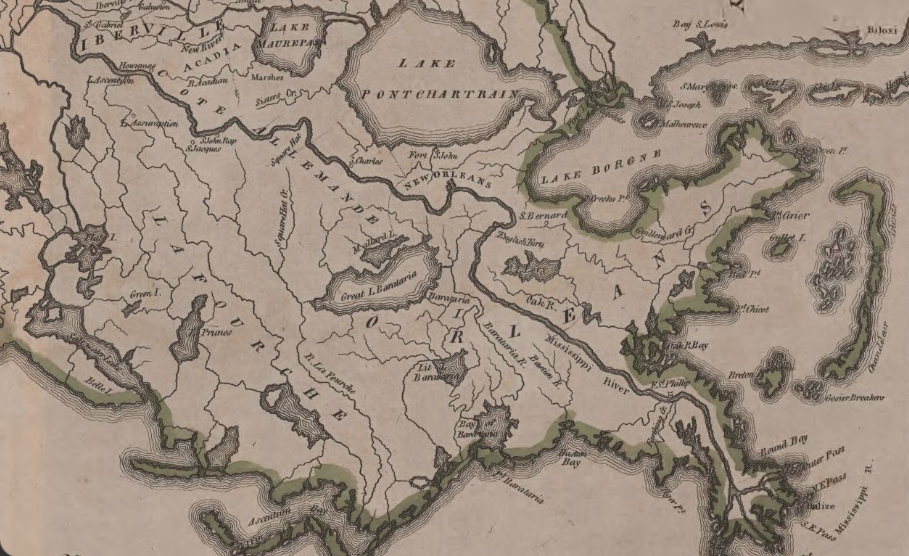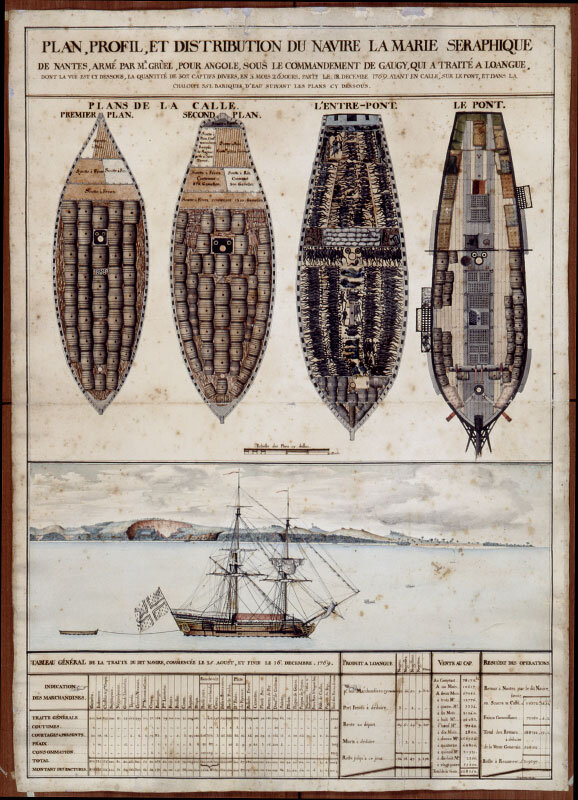The impoverished Germans sought new lives in Louisiana, but in doing so began occupying land on which Native Americans had lived for centuries. For the Germans, who were already coping with disease and the hardships of clearing the swamps and making a home in a challenging climate and difficult land, the threat of attack from Native Americans proved especially daunting. Meanwhile Native Americans, who had a history of cooperating with the French and assisting them in surviving in the new colony, felt angered and betrayed. They had lived, worked, hunted, and wandered freely along the banks of the Mississippi long before any Europeans had even thought of settling there. This was not a New World to them, but an ancient and old one.
Choctaw Village near the Chefuncte, by Francois Bernard, 1869, Peabody Museum – Harvard University.
French colonial Louisiana also suffered pushback from the British, who were penetrating deeper into the frontier and threatening French territory. The two superpowers were almost constantly at war with each other. They involved Native Americans in their rivalries and incited violence against each other through nearby tribes. Ultimately this dynamic would lead to the French and Indian War. Though we think of this as being primarily a New England event, it actually had lasting implications for Louisiana. After England defeated France, the French would cede Louisiana to the Spanish, preferring to have an ally take the colony rather than their enemies.
Native Americans were crucial to the survival of the early colony and contributed many unique elements to the cultural heritage we now call Creole. Their cane basketry, dugout canoes that were precursors to pirogues, use of filé were all adopted by the French. Their foodways contributed to some of the defining parts of Creole cuisines, including alligator, shellfish, crawfish, frog legs, and waterfowl. Their language is forever present in our geography: place names, waterways, parishes, and towns all bear names with Native American roots. Even Louisiana’s unique moniker, The Bayou State, is derived from the Choctaw word bayuk (bayou).
What follows are excerpts from letters written by the Marquis de Vaudreuil, colonial governor of Louisiana from 1743 to 1753, to Antoine Louis Rouillé, French minister of Marine and Colonies. They reflect conditions along the German Coast (Côte des Allemands) when Christophe Heidel (Haydel) was coming of age. Just two years after these letters were written, he married and started a family. His daughter Magdelaine, born at a time when the French flag flew over Louisiana and the Heidels feared conflict with neighboring Native Americans, gave birth to her children when Spain controlled Louisiana. At the time of her death, the stars and stripes had been raised over the land, Louisiana was officially a state in a country that had not existed at the time of her birth, and the frontier atmosphere of early Louisiana was a distant memory.
Governor Pierre Rigaud Cavagnol Marquis de Vaudreuil. Molinary, Andres (Painter). COURTESY OF THE LOUISIANA STATE MUSEUM.
March 3, 1749
[M. de Vaudreuil, the governor] also states that the English do not cease, in peace as in war, to work at setting the nations against the French, and that some traders who had armed the Choctaw party that attacked the village of the Germans, having bought the daughter of one of the inhabitants [who had been] carried off by this party, took her to Carolina, where it has been learned that the governor was doing everything in his power to induce other parties to make raids upon Louisiana.
July 27, 1749
I have the honor to send you by the first vessel that departs for France the map of the German coast, on which will be marked the places by which the enemies may come to make their raids there and the one where I think it would be advisable to establish a post. I am having this map made by Sieur Saucier, whom I have brought with me from Mobile, since he is the man who is best fitted to travel through this almost impassable country and since he has already several times examined the swamps, streams, and ravines by which the Indians may make their way to the settlement of the Germans.
All that I can assure you, my lord, is that I will neglect nothing to assure this colony of a perfect tranquility as well as that I will strive for its increase.
February 1, 1750
The new recruits who are to come on this vessel would be of great assistance in the circumstances. We have so few people here that M. de Vaudreuil cannot without impairing the service or disturbing the posts form a detachment that would be necessary and even indispensable to protect the German quarter against the incursions of the Choctaws. The minor attacks that this nation has made in that quarter have struck terror into it and obliged part of those settlers to withdraw to town with their families. Their lands are abandoned, and in addition to the delay in their settlement and in that of the colony that that causes, the town is deprived of the comforts that those settlers provided for it by their industry and their thrift.
From Mississippi Provincial Archives Vol. V., French Dominion, 1749-1763, Collected, Edited, and Translated by Dunbar Rowland and A.G. Sanders, LSU Press, 1984.




